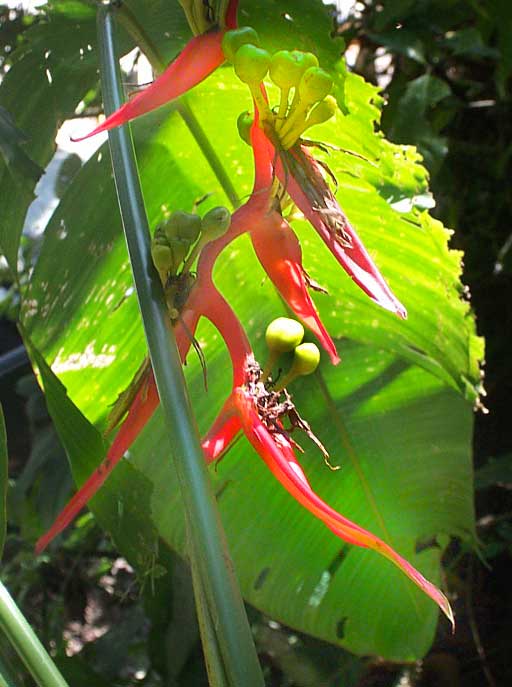Excerpts from Jim Conrad's
Naturalist Newsletter
from the June 9, 2007 Newsletter issued from Sierra Gorda Biosphere Reserve, QUERÉTARO, MÉXICO
LOBSTER CLAW
On the little gravel road from Xilitla to San Juan de los Durán, at an elevation of about 1200m (3900ft), around N21.40°, W99.04°, on a steep slope in dense, moist shade along the road, I spotted something red glowing in a ray of sunlight, went to investigate, and found a Lobster Claw, sometime also called Parrot's Beak and Fire and Ice. It was a very pretty member of the Banana Family, HELICONIA SCHIEDEANA, and you can see it below:

As its raggedy leaf in the background indicates, this was an old plant. The red, snaky items are bracts, or modified leaves, helping draw pollinators' attention to the flowers of this plant, which often grow in deep forest shade. This plant's yellow flowers had been pollinated and subsequently dried up long ago -- you can see the blossoms' shriveled, brown remains still nested atop the red bracts. The spherical, stalked items are maturing fruits.
Though Lobster Claw is a native Mexican plant the species is planted in gardens worldwide. It's regarded as relatively easy to grow and can stand a little frost, which sounds about right for a plant occupying a high-elevation secondary forest like the one we were picnicking beside.
Noticing the plant's broad, glossy leaf in the background, it's easy to believe that Lobster Claw is a member of the Banana Family. One feature distinguishing banana plants from heliconias is that leaves and bracts are spirally arranged on banana plants (visualize bananas clustered all around the central fruit-stalk) while in heliconias leaves and bracts alternate from one side of the stem to the other (they're "distichous"), often zigzagging. Also, banana fruits don't split open when ripe (they're indehiscent) while heliconia's three-seeded fruits do split open (dehisce) at maturity.